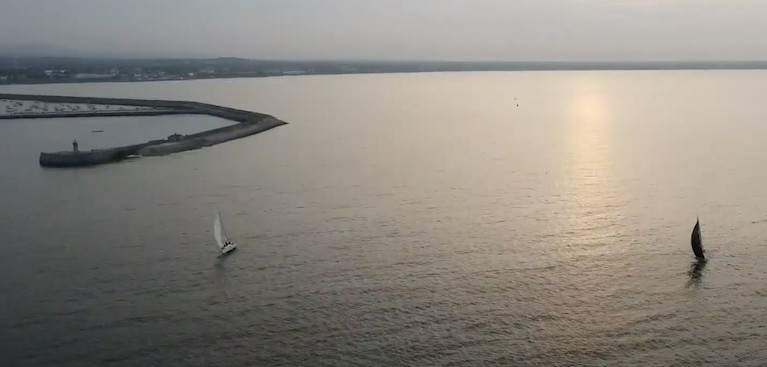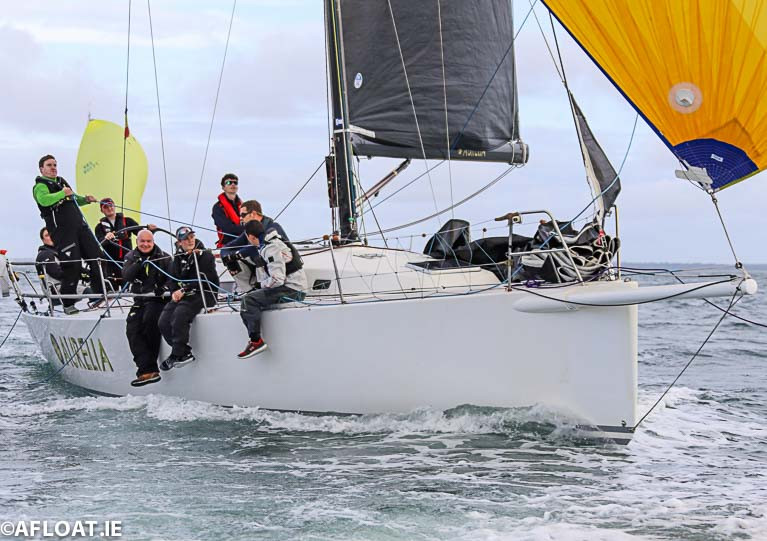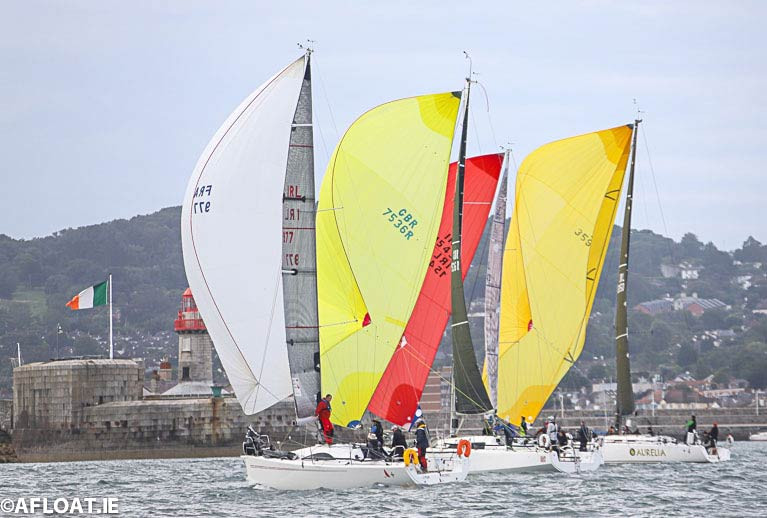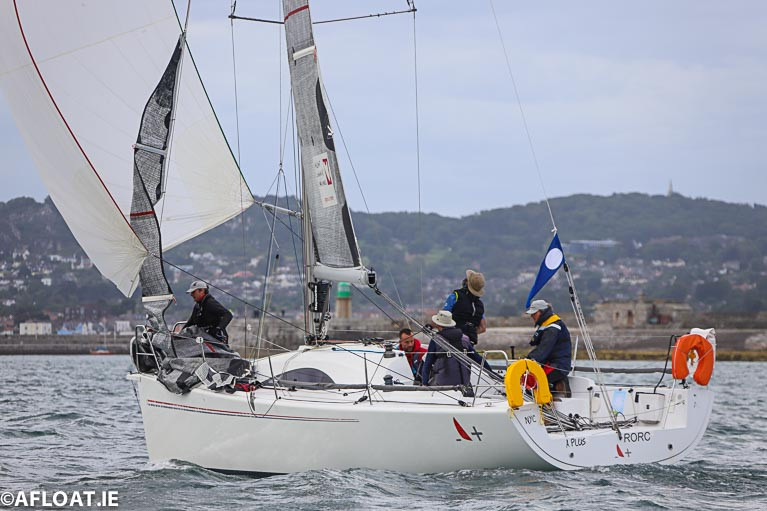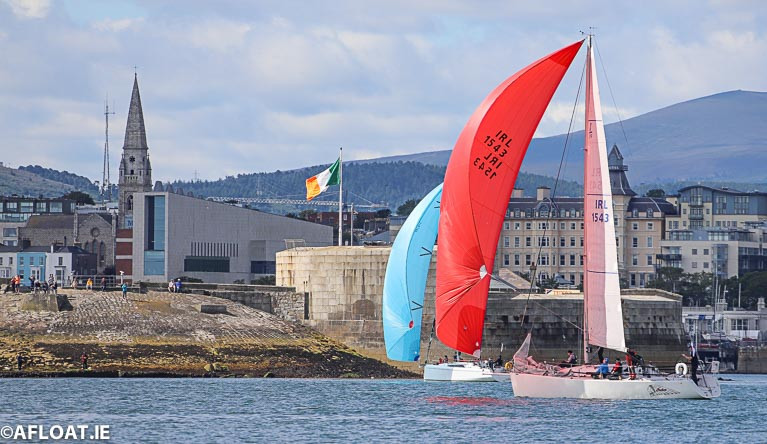Displaying items by tag: ISORA
Royal Irish's Rockabill VI Wins ISORA Night Race (Start Video HERE!)
ISORA Champion Rockabill VI was the overall winner of Friday's 40-mile night race. Although short on entries, the seven boat fleet was made up of the leading contenders for this year's Irish ISORA overall prize.
It was the defending champion, Paul O'Higgins of the Royal Irish Yacht Club, in the JPK 10.80 who won out however in the first-ever ISORA race to use virtual marks entirely.
 ISORA Night Race overall results
ISORA Night Race overall results
Dublin Bay Cruisers One sailor Darius Kry captured the start of the race by drone at Dun Laoghaire Harbour and his footage is below.
Six of the seven starters last night are signed up for next Saturday's inaugural 270-mile Fastnet 450 Race from Dublin to Cork.
It's not the biggest ISORA fleet but all seven boats in contention are on the starting list for tonight's race that could yet decide the Irish championship.
Tonight's course will use 100% virtual marks – another first for ISORA. Race finish times will be recorded by the onboard trackers that provide instant results. (see tracker below)
The night race will also stand to those boats who are competing in the inaugural Fastnet 450 Race from dun Laoghaire to Cork next Saturday.
 Race six's ISORA starters in tonight's 40-mile night race on Dublin Bay
Race six's ISORA starters in tonight's 40-mile night race on Dublin Bay
The Irish ISORA championship includes the Irish coastal and offshore and will be the defacto top award in 2020 after the cancellation of the cross-channel Wolf's Head Trophy due to COVID-19.
Overall, the coastal results don’t tend to count as weightings are applied to the offshore races. Tonight's fixture is weighted 1.1. The last race on the 5th September is 1.3!
Tonight's 40-mile course is as follows:
- STARTING LINE at Dun Laoghaire
- ISORA Dublin Virtual Mark (P) N53 17.110 W6 00.100
- Virtual Mark (P) N53 27.99 W04 40.00
- ISORA Dublin Virtual Mark (P) N53 17.110 W6 00.100
- FINISH LINE at Dun Laoghaire
In the meantime, there are ISORA coastal races being run in Pwllheli as part of the Welsh IRC Nationals.
Live Dublin Bay webcam here and Race Tracker below
When John Harington's IMX 38 Excession made the Dun Laoghaire Harbour startline on Saturday morning, he became the first Northern Ireland yacht to compete in ISORA racing in many years,
The enthusiastic Royal Ulster Yacht Club crew from Bangor on Belfast Lough sailed down for the 8 am Dublin Bay start, completed the 70-mile race, turned on the finish line, refuelled and headed straight back to RUYC to complete a race there later on Sunday! The crew were rewarded for their efforts with a third in ISORA's IRC Class One.
ISORA Chief Peter Ryan and the whole Dublin fleet gave the Belfast crew a warm welcome into the Bay. The hope now is that the Northern Ireland crew will consider future offshore races on the Irish Sea. 'They are a great bunch of guys and I hope they and more from RUYC will be active participants in ISORA", Ryan told Afloat.
For the second week running, a smaller class two boat has won one of ISORA’s long offshore races in tricky light winds off the Dublin coast.
After a 15-hour marathon, the Grzegorz Kalinecki skippered First 310 More Mischief sailed into Dun Laoghaire Harbour to finish last night in darkness as the Class Two and overall IRC winner two in the 15-boat fleet.
Provisional results via ISORA's Yellowbrick tracker put two-class boats in the top three overall after the long race in light northerly breezes that took the fleet from Dublin Bay to North Dublin before a long reach to County Wicklow. The full course at 8 am was from Dun Laoghaire Harbour to a virtual mark to Bennett Bank to Rockabill to East Kish to Breeches, Muglins and a finish in dusk or total darkness at Dun Laoghaire Harbour. a total of 7o nautical miles.
 (Above and below) With just seconds to the start of ISORA's Race 5a off Dun Laoghaire Harbour, Rockabill VI and the Sunfast 3600 YoYo look for the advantage at the Committee boat end of the start line
(Above and below) With just seconds to the start of ISORA's Race 5a off Dun Laoghaire Harbour, Rockabill VI and the Sunfast 3600 YoYo look for the advantage at the Committee boat end of the start line




Kalinecki's 30-footer took some big scalps including the reigning champion Rockabill VI (Paul O’Higgins) that again made an impressive start to yesterday’s fifth race of the season and was the Class Zero winner. Last weekend in a fifty miler, Rockabill VI also showed impressive form only to be beaten by the A31 A Plus when the wind died and smaller boats caught up over the race four-course, as Afloat reported here.
 Gently does it! Even a loudly spoken sentence seems to threaten the collapse of spinnakers in the light north wind. J109 Indian (Red) leads Samaton (Pink) and White Mischief (Black)
Gently does it! Even a loudly spoken sentence seems to threaten the collapse of spinnakers in the light north wind. J109 Indian (Red) leads Samaton (Pink) and White Mischief (Black)
 Shortly after the start, the 15-boat fleet head for the first virtual mark on the 70-mile course Photo: Afloat
Shortly after the start, the 15-boat fleet head for the first virtual mark on the 70-mile course Photo: Afloat
 The overall winner, the Grzegorz Kalinecki skippered First 310 More Mischief (black spinnaker) makes her way out of Dublin Bay Photo: Afloat
The overall winner, the Grzegorz Kalinecki skippered First 310 More Mischief (black spinnaker) makes her way out of Dublin Bay Photo: Afloat
The Line Honours winner in an elapsed time of 13h 33m 6s was Chris Power Smith’s Aurelia from the Royal St. George Yacht Club. Third on class Zero was early season performer, George Sisk’s XP44, WOW.
 George Sisk's WOW and John O'Gorman's Hot Cookie Photo: Afloat
George Sisk's WOW and John O'Gorman's Hot Cookie Photo: Afloat
Sailing fully crewed as opposed to two-handed for the first time this season, Andrew Algeo’s J 99 Juggerknot II was second overall and the IRC One winner. Second in Class One was the Simon Knowles skippered Howth J109, Indian. Third in class was a new arrival in ISORA racing, the John Harrington skippered IMX 38 Excession.
 Andrew Algeo's Juggerknot II from the Royal Irish Yacht Club was second overall and sailing fully crewed for Race 5
Andrew Algeo's Juggerknot II from the Royal Irish Yacht Club was second overall and sailing fully crewed for Race 5
Second to Kalinecki’s More Mischief in Class Two was Desert Star, the Ronan O’Siochru Irish Offshore Sailing School’s Sunfast 37 that also finished third overall, in another coup for class Two. Third in Class Two was Steve Hayes’ First 34.7, Magic Touch.
 Line honours winner Chris Power Smith's J122 Aurelia, included ISORA Chairman Peter Ryan (second from right) on the crew for Race five Photo: Afloat
Line honours winner Chris Power Smith's J122 Aurelia, included ISORA Chairman Peter Ryan (second from right) on the crew for Race five Photo: Afloat
This is the first race of the 2020 season since news broke that racing for ISORA's overall Wolf’s Head Trophy would be scrapped this season following the abandonment of cross channel racing.
 Ronan O’Siochru Irish Offshore Sailing School’s Sunfast 37 Photo: Afloat
Ronan O’Siochru Irish Offshore Sailing School’s Sunfast 37 Photo: Afloat
A new offshore race has been announced, the Fastnet 450 from Dublin to Cork on August 22nd, the same date as the cancelled Round Ireland Race. The new fixture is attracting some strong entries including some ISORA regulars including Algeo's J/99 and the Kalinecki Polish-based crew too.
Saturday's ISORA long offshore race from Dun Laoghaire to Dun Laoghaire is expected to be 80 miles in length but with light winds forecast the expected 16-boat Dublin Bay fleet will not know the course until shortly before the 8 am start time.
Winds are forecast to be northerly and only five knots in strength presenting the race committee with a challenge to set a course off the Dublin coast.
It won't be the only light air challenge this season either with last Saturday's 50-mile racing turning inside out and allowing smaller boats to take the lead. It was a scenario that allowed ISORA debutante A Plus to take a race win in the 11-boat fleet that included ISORA champion Rockabill VI of the Royal Irish Yacht Club.
ISORA Race 5a Race Tracker
In a major change to ISORA's rebooted season, the offshore body is cancelling plans for any further attempt at cross channel racing this season.
It is the latest blow for Irish Sea offshore sailing fans and follows the loss of this month's Round Ireland Yacht Race.
In view of the COVID situation in UK and Ireland and the present regulations in force, a meeting of ISORA's Sailing Committee unanimously decided that there will be no cross channel races and instead there will be races on each side of the Irish Sea. In view of this, the Wolf’s Head Series is being abandoned for 2020, ISORA Chairman Peter Ryan told Afloat.
'This was a very difficult decision for ISORA where the Wolf's Head trophy has been presented every year since it was first presented to ISORA in 1977 but the safety of all competitors is our primary concern and we are of course guided by the rules and regulations of the separate Nations, Ryan said.
Competitors will compete for the respective championship titles on either side of the Channel, the Coastal Series, Class Results and the Silver Class.
 ISORA's Wolf's Head Trophy - racing abandoned for ISORA's Top award for the first time in 43 years Photo: GPPhoto/ISORA
ISORA's Wolf's Head Trophy - racing abandoned for ISORA's Top award for the first time in 43 years Photo: GPPhoto/ISORA
Should the situation improve significantly later this month, resulting in a relaxation of the regulations, the last race, the James Eadie, may proceed as planned from Pwhelli to Dun Laoghaire.
On Saturday, ISORA ran two separate offshore races on either side of the Irish Sea in a bid to keep the offshore scene alive in spite of the pandemic.
The revised schedule will be published shortly with the appropriate amendments and revised Supplemental Sailing Instructions.
ISORA Debutante 'A Plus' Wins Dun Laoghaire Offshore Race
Despite similar conditions as the three previous ISORA coastal races, Saturday's first offshore at nearly double the distance off Dun Laoghaire has produced substantially different results, with National Yacht Club Class two newcomer A Plus (Mick Flynn and Grant Kinsman) taking the IRC win overall.
The Wolf's Head qualifying race turned inside out when the wind died mid-race and smaller boats caught up with the leaders.
 Neck and neck as weather boat J122 Aurelia, Sunfast 3600 Hot Cookie and eventual winner the Archambault A31 pass Dun Laoghaire Harbour Mouth
Neck and neck as weather boat J122 Aurelia, Sunfast 3600 Hot Cookie and eventual winner the Archambault A31 pass Dun Laoghaire Harbour Mouth
Provisional results published by ISORA here give second overall to Class 1 J99, Juggerknot 2, sailed double-handed by Royal Irish Yacht Club duo Andrew Alego and Mark McGibney. Third was More Mischief the Grzegorz Kalinecki skippered First 310.
 (Above and below) Sailing double-handed with Mark McGibney, Royal Irish skipper Andrew Algeo (above) was second overall in the 50-miler and the IRC One winner Photo: Afloat
(Above and below) Sailing double-handed with Mark McGibney, Royal Irish skipper Andrew Algeo (above) was second overall in the 50-miler and the IRC One winner Photo: Afloat
 Juggerknot II, a J99 in double-handed configuration is the only two-hander in the 2020 ISORA racing offshore series Photo: Afloat
Juggerknot II, a J99 in double-handed configuration is the only two-hander in the 2020 ISORA racing offshore series Photo: Afloat
Starting at 8 am at the Dun Laoghaire outfall buoy, the 11-boat fleet sailed a 50-mile course first to a Virtual Mark then to Kish light, South Codling, South India and the Muglins before finishing off Dun Laoghaire Pier Heads yesterday evening at tea time. The tracker is here. Light Westerly winds never got over 10-knots.
Reigning ISORA champion Rockabill VI (Paul O'Higgins) crashed out of the running and finished eighth in IRC overall.
 Rockabill VI made an impressive downwind start right on the gun
Rockabill VI made an impressive downwind start right on the gun
 John O'Gorman's Sunfast 3600 'Hot Cookie' was the IRC Class Zero winner. Multiple Irish Fireball champion Noel Butler on helm (left) Photo: Afloat
John O'Gorman's Sunfast 3600 'Hot Cookie' was the IRC Class Zero winner. Multiple Irish Fireball champion Noel Butler on helm (left) Photo: Afloat
The race was the first qualifying race of the 2020 season for the Wolf's Head trophy but due to COVID-19, the ISORA fleet did not race cross channel but instead competed separately in two different offshores, one in Dublin and one off Pwlhelli, as Afloat previously reported.
Pwllheli Offshore Race
A turnout of just three boats for the Welsh edition saw Nigel Ingram's J109 Jetstream from Holyhead Sailing Club win from Andrew Hall's J125, Jackknife.
ISORA Race 4a slideshow below
First for ISORA as Offshore Fleet Races Separately in Wales & Ireland for Wolf's Head Trophy
In a first-ever for ISORA, there will be two separate offshore qualifying races for its overall Wolfs Head Trophy this Saturday, one in Ireland and one in Wales.
The change arises from differences in COVID-19 regulations on either side of the Irish Sea. It's something of a bravo move by ISORA chiefs aiming to keep channel racing going in a week that has already seen the Round Ireland Race, the highlight of the offshore calendar, fall victim to the pandemic.
28 boats are entered so far for the first offshore of the season over a course size of 55-miles, nearly double the length of recent coastal races.
ISORA's top prize for the famous Wolf's Head is decided over the best of five races but this must include three qualifying offshore races. These races are long offshore courses and traditionally cross channel.
Unfortunately, though, differences in crew number limitations, port access and difficulties with overnight stays onboard have all conspired to make it impossible to run a qualifying race which is equitable and equally available to all competitors.
The result is that Saturday's racing will be scored taking account of the respective fleet sizes in both races.
Given ISORA entries currently show only two Welsh boats entered, it looks like it will be a small race in Wales and a larger race from Dublin Bay.
 ISORA's Wolf's Head Trophy for overall honours racing offshore in the Irish Sea Photo: GP Photo
ISORA's Wolf's Head Trophy for overall honours racing offshore in the Irish Sea Photo: GP Photo
ISORA racing in these difficult times has only been possible because of the association's investment in technologies which allow remote desk-top race management and as ISORA's Stephen Tudor told Afloat, [the association is] "Making the best of difficult times to get sailors on the water both sides of the Irish Sea!"
Saturday's race four consequently is a 55 miler, weighted 1.1. In Ireland, it will be a Dun Laoghaire offshore and back to Dun Laoghaire and in Wales from Pwllheli to Pwllheli. The course will be published by 1200hrs on Friday, 31st July. The forecast for Dublin Bay indicates more light westerlies that have been a feature of ISORA's 2020 Viking Marine Coastal Series thus far.
The dominant form of the 2019 Irish yacht of the year, Paul O'Higgins' JPK10.80 Rockabill VI continues to stalk the ISORA racecourse, picking up another win at 1.30 am this morning off Dun Laoghaire Harbour in the well attended night race, according to provisional results via the ISORA Yellowbrick tracker.
The 25-boat race was the third in the ISORA 2020 Re-Boot series and the third race of the Viking Marine sponsored Coastal Series of four.
The fleet started off Dun Laoghaire outfall buoy at 8 pm (the same as race one and two) and headed south to the Muglins and onto Breeches just north of Wicklow before heading back up the Dublin coast and a finish off Dun Laoghaire Pier heads.
 Rockabill VI Paul O'Higgins' JPK10.80 was the overall winner of the ISORA night race
Rockabill VI Paul O'Higgins' JPK10.80 was the overall winner of the ISORA night race
Aurelia was line honours winner
Chris and Patanne Smith's J122 Aurelia from the Royal St George Yacht Club was the line honours winner but dropped to second overall on corrected time over the 32-mile course sailed in light south and south-west winds.
Third overall was the National Yacht Club's First 40.7 Tsunami (Vincent Farrell) in a clean sweep for Class Zero boats.
 Vincent Farrell's First 40.7 Tsunami from the National Yacht Club
Vincent Farrell's First 40.7 Tsunami from the National Yacht Club
J99 wins IRC One
In IRC Class One, Andrew Algeo's J/99 took the gun from the J/109 Mojito with Prima Luce, third.
 Patrick Burke's Prima Luce was third in IRC One
Patrick Burke's Prima Luce was third in IRC One
Black Velvet Takes IRC Two win
Leslie Parnell's Beneteau 34.7 Black Velvet from the Royal Irish Yacht Club was the Class Two winner from Greystones Harbour JOD 35 entry Red Alert. Third was Humdinger.
Royal Irish's Rockabill VI Makes Right Move to Win ISORA's Second Viking Marine Coastal Race
Reigning ISORA Champion Rockabill VI (Paul O'Higgins) took a one-minute 35-second margin on corrected time to win the second ISORA Viking Marine Coastal Race on Dublin Bay this afternoon.
The JPK10.80 was the IRC overall and Class Zero winner according to provisional results published by ISORA via the association's tracker that are subject to official confirmation.
 XP 44 WOW overtakes the Greystones JOD 35 Red Alert shortly after the reaching start
XP 44 WOW overtakes the Greystones JOD 35 Red Alert shortly after the reaching start
Second overall was the Howth Yacht Club J109 Indian (Colm Buckley and Simon Knowles) who was also the Class One winner.
 Howth Yacht Club J109 Indian (Colm Buckley and Simon Knowles) was the Class One Winner
Howth Yacht Club J109 Indian (Colm Buckley and Simon Knowles) was the Class One Winner
The fleet contained a number of new entries for the second of the four-race mini-series including the new First 40 to Dublin Bay, Prima Forte and the Channel 32 Wavetrain from Greystones Sailing Club.
 The gleaming varnish of the Channel 32 Wavetrain from Greystones takes the Committee Boat end at the start of the second ISORA Viking MarineCoastal Race
The gleaming varnish of the Channel 32 Wavetrain from Greystones takes the Committee Boat end at the start of the second ISORA Viking MarineCoastal Race
 Rockabill VI (Paul O'Higgins) going well in the light winds under symmetric spinnaker
Rockabill VI (Paul O'Higgins) going well in the light winds under symmetric spinnaker
O'Higgins of the Royal Irish Yacht Club gave a fine display on how to navigate Dublin Bay's tidal currents even though hugging the Dublin Bay shoreline did not always look like the right move in the fickle sub-ten-knot westerlies as the 19-boat fleet started from the Dun Laoghaire Harbour's outfall Mark in Seapoint Bay.
 The First 40 'Prima Forte' on its first ISORA race
The First 40 'Prima Forte' on its first ISORA race
Early into the 24-mile race, it appeared that boats such as first race winner George Sisk's WOW, an XP44, had secured the best pressure in the centre of the course in the light westerlies as the feet raced towards the first mark at the Muglins at the southern tip of Dublin Bay.
It became obvious though as the fleet exited the Bay that O'Higgins's ploy to hug the Scotsman's Bay shore in the south of the Bay in the last of the ebb tide was a race-winning move.
 John Treanor's Grand Soleil 34 Justina from the National Yacht Club
John Treanor's Grand Soleil 34 Justina from the National Yacht Club
Second in Class One was the Grand Soleil 34, Justina, skippered by John Treanor, from the National Yacht Club who followed a similar strategy.
 The Royal St. George Yacht Club J97 Windjammer steered by Fireball ace Noel Butler
The Royal St. George Yacht Club J97 Windjammer steered by Fireball ace Noel Butler
Class Two in the four-hour race was won by Leslie Parnell's First 34.7 Black Velvet who won from the Royal St. George J97 Windjammer.


























